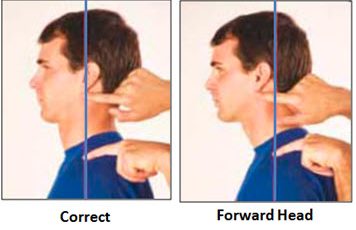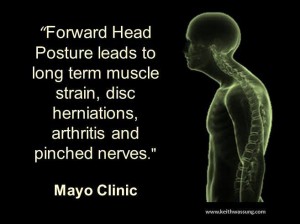If you’re constantly sitting at a computer, using your smartphone or otherwise engaging in activities that thrust your neck into an unnatural position, you may be suffering from Forward Head Posture (FHP). The suffering typically includes headaches, stiffness and neck pain, but your symptoms don’t have to continue. A mix of orthopedic manual therapy, Foundation Training, and Pilates can help realign your spine and pelvis, rebalance your body and ensure proper posture becomes a part of your daily life.
What It Is
Think of a vertical line running up through your spine. In a perfect world where everyone had perfect posture, your head would be balanced directly above your spine in alignment with that vertical line. Forward head posture occurs when you consistently hold your head in an excessive forward position. This position, in turn, extends your middle cervical spine, flexes your lower cervical spine and plagues you with rounded shoulders and a hunched back.¹

Who Gets It
You’re a prime candidate for FHP if you sit at a computer all day, are an avid smartphone user or play a musical instrument that forces you to contort your head to hold the instrument in place. Computer screens, smartphones and sheet music perched on stands are often placed below eye level, forcing folks to thrust their heads forward for better viewing.
People who carry heavy backpacks, especially children, are often prone to FHP, thrusting their heads forward in an attempt to compensate for the heavy weight on their backs. People who wear glasses with multifocal lenses or are fans of high heeled shoes often fall prey to FHP, as do those who breathe through their mouths, rather than their noses.² ³ ⁴
What It Does to Your Health
FHP can bring on neck pain, sore shoulders, respiratory weakness and a variety of headache types.¹ ⁵ ⁶ ⁷ Tension headaches are particularly common, thanks to the ongoing tension FHP places at the back of the neck.⁸ As the jaw muscles try to offset or compensate for the unnatural positioning of the head, temporomandibular disorders can also crop up, especially temporamandibular joint dysfunction, also known as TMJ.⁹

Keep up this poor posture as an ongoing habit, and you can eventually suffer from muscle imbalances that affect your entire body. Muscles held long enough in a chronically lengthened or shortened position will begin to believe that’s their natural state and strive to adapt. The end result is a “faulty relationship” among the various parts of your body, increasing the strain and decreasing your body’s performance.¹⁰ ¹¹ ¹²
How to Fix It
Realizing you’re engaging in FHP is the first step toward its correction, as is learning what constitutes the natural positioning of your head and overall posture.¹³ Realigning the spine is the next step, which can be helped through thoracic manipulation as part of an orthopedic manual treatment plan.¹⁴ The third and final step is maintaining proper posture in all your activities, a move that can be achieved through Foundation Training and Pilates.
Exercise programs that stretch and strengthen affected muscles have been effective for FHP and posture correction, particularly those that stretched the pectoralis muscles and strengthened the deep neck flexor and shoulder retractors.¹ Stretching and strengthening are two major focuses of Pilates and Foundation Training, both for targeted muscles as well as the entire body.
Its overall focus on elongation, proper spinal alignment and breathing makes Pilates and Foundation Training an ideal long-term way to treat and prevent future instances of FHP. One more bonus is the mindfulness and body awareness both exercise program produces, which can help people adjust their environment and their positioning to help ensure proper posture is a way of life.
REFERENCES:
-
Dimitriadis Z, Kapreli E, Strimpakos N, Oldham J. Respiratory weakness in patients with chronic neck pain. Man Ther. 2012;18:248-253.
-
Hills Willford C, Kisner C, Glenn T, Sachs L. The Interaction of Wearing Multifocal Lenses With Head Posture and Pain. JOSPT. 1996;23(3):194-199.
-
Martins Silva A, Rocha de Siqueira G, P. da Silva G. Implications of high-heeled shoes on body posture of adolescents. Rev Paul Pediatr. 2013;31(2):265-71.
-
Tiemi Okuro R, Moreno Morcillo A, Gonçalves M, Ribeiro O, Sakano E, Blau Margosian Conti P, Dirceu Ribeiro J. Mouth breathing and forward head posture: effects on respiratory biomechanics and exercise capacity in children. J Bras Pneumol. 2011;37(4):471-479.
-
Jull G, Barrett C, Magee R, Ho P. Further clinical clari?cation of the muscle dysfunction in cervical headache. Cephalalgia. 1999;19:179–85.
-
Kidd RF, Nelson R. Musculoskeletal dysfunction of the neck in migraine and tension headache. Headache.1993;33:566–9.
-
Haughie LJ, Fiebert IM, Roach KE. Relationship of forward head posture and cervical backward bending to neck pain. J Manual Manipulative Ther. 1995;3:91–7.
-
Fernández-de-las-Peñas C, Alonso-Blanco C, Cuadrado ML, Pareja JA. Forward head posture and neck mobility in chronic tension-type headache: a blinded, controlled study. Cephalalgia. 2005;26:314–319.
-
Aksoy E. Relationships between head posture and temporaomandibular dysfunction syndrome. J Musculoskel Pain. 2004;12:19-14.
-
Kendall FP, McCreary EK, Provance PG. Muscles Testing and Function. 4th ed. Baltimore: Williams & Wilkins; 1993.
-
Mannheimer JS, Rosenthal RM. Acute and chronic postural abnormalities as related to craniofacial pain and temperomandibular disorders. Dent Clin North Am. 35(1):185-208, 199.
-
Sahrmann S. Diagnosis and treatment of muscle imbalances and musculoskeletal pain syndromes. Continuing education course notes, St. Louis, MO, January, 1992.
-
Hanney W, Kolber M, Schack-Dugre J, Negrete R, Pabian P. The Influence of Education and Exercise on Neck Pain. Am J Lifestyle Med. 2010:166-175.
-
Lau HM, Wing Chiu TT, Lam TH. The effectiveness of thoracic manipulation on patients with chronic mechanical neck pain e a randomized controlled trial. Manual Therapy 2011;16(2):141-7.
